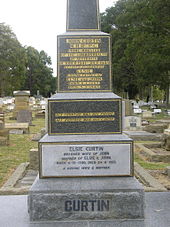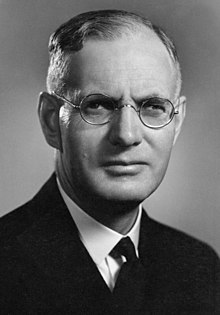John Curtin
John Joseph Curtin (born January 8, 1885 in Creswick , Victoria , † July 5, 1945 in Canberra , Australian Capital Territory ) was the 14th Prime Minister of Australia . His term of office lasted from October 7, 1941 to July 5, 1945. He died in office. From October 1, 1935 to October 7, 1941 he was the leader of the opposition.
The time before he became Prime Minister (until October 1941)
John Joseph Curtin (the third name Ambrose was only added at the age of 14 through his confirmation) was born in Creswick as the eldest of four siblings of John Curtin and Catherine "Kate" Bourke. His father had to give up his job as a police officer for health reasons when John Curtin was five years old. As a result, he was forced to go to work at the early age of 14 in order to support the family. It took him four years to finally find a permanent job as an accountant in a Melbourne factory.
John Curtin's interest in politics was sparked by his mother and so he joined a committee in 1901 that can be seen as one of the forerunners of the Australian Labor Party (ALP) in Victoria. In addition, from 1905 he was also involved in the Victorian Socialist Party (VSP) , which had been founded shortly before by an acquaintance.
In 1911 he quit his previous job at the factory to become a permanent secretary of the Victorian Timber Workers Union , a union for timber and forest workers. This enabled him to further intensify his commitment to the ALP .
During the First World War he vehemently opposed conscription in Australia and was one of the leading figures in the campaign that was directed against it. At the end of 1916 he was even briefly detained because he refused to register for possible military service.
After asking for Elsie Needham's hand in 1914, he was finally able to marry her on April 21, 1917. Together they had a daughter (1917) and a son (1921).
In March 1917, two months before his marriage , he moved to Western Australia to accept the position of editor of the Western Ralian Worker , a union newspaper. He held this position successfully until 1928.
In 1928 he was able to win a seat in the House of Representatives for the constituency of Fremantle , now in the third attempt after 1919 and 1925 . After the ALP won the elections in October 1929 with a large majority, he was able to successfully defend his parliamentary seat, he figured out chances of a ministerial post in James Scullin's cabinet . However, he was not taken into account due to disapproval of his alcohol problems, which he had had repeatedly since 1916. In new elections in 1931, which were heavily influenced by the Great Depression, he lost his mandate, but was able to regain it in 1934.
When Jim Scullin resigned from the party leadership of the ALP on October 1, 1935 , surprisingly John Curtin was elected by one vote ahead of his competitor, the supposedly certain favorite Frank Forde . He also became the leader of the opposition. In relation to the government of Joseph Lyons , he could hardly distinguish himself with his politics. This only changed after his death in 1939. The ALP almost won a government majority in the 1940 elections, while as party chairman he was only able to maintain his own constituency of Fremantle by a narrow margin of 600 votes.
The time as Prime Minister (from October 1941)
The two independent parliamentarians in the House of Representatives, who initially supported the Robert Menzies government after the 1940 election , now supported the ALP's policy from autumn 1941 . John Curtin was able to be appointed Prime Minister of Australia on October 7, 1941 and form a government.
His entire reign was determined by the Second World War , which began in December 1941, exactly two months after he took office, in the Pacific . As early as February 19, 1942, Japanese aircraft were able to attack the city of Darwin in northern Australia, so that a Japanese invasion became a real and serious threat.
In light of this situation, John Curtin made three important and very controversial decisions:
- Relocation of the Australian armed forces to Australia, which so far intervened in the Middle East in the war so that they could defend the motherland and intervene decisively in the Pacific War .
- Appeals to the US for direct military support. In this context he transferred the US General Douglas MacArthur , who was commissioned from March 1942 to organize the Allied defense war in the Pacific, the supreme command of the Australian troops.
- Although he was a staunch opponent of conscription during the First World War, he could not avoid introducing it against the will of his party .

By 1943, the direct threat to Australia was averted, so that he was able to win the parliamentary elections in August of the same year for the ALP .
John Curtin's health was always not the best and so the quarrels that were connected with his decisions left clear traces on him. He was also a heavy smoker by the way.
After an overseas trip to London in May 1944, where he attended a conference of the Prime Ministers of the Commonwealth to set the course for the post-war period, he was unable to recover from the burdens of his office. He lived to see the end of the war in Europe on May 8, 1945, but had to leave the public announcement to his deputy and successor, Ben Chifley . In the end, he was no longer allowed to witness the end of the war in the Pacific on September 2, 1945. He died in Canberra on July 5, 1945.
Web links
- David Day, Chapter 7. John Curtin: Taking his Childhood Seriously , Australian Political Lives: Chronicling political careers and administrative histories
- John Edwards, Curtin's Gift: Reinterpreting Australia's Greatest Prime Minister , Allen & Unwin, 2005
- John Curtin Prime Ministerial Library Curtin University of Technology, Western Australia
- WW2DB: John Curtin
- John Curtin (1885–1945) Australian Dictionary of Biography, Online Edition
- John Curtin Australian Journalist - English and Media Literacy, Australian Biography on dl.filmaust.com.au - Prime Ministers' Natural Treasures
- Newspaper article about John Curtin in the 20th century press kit of the ZBW - Leibniz Information Center for Economics .
| personal data | |
|---|---|
| SURNAME | Curtin, John |
| ALTERNATIVE NAMES | Curtin, John Joseph Ambrose (full name) |
| BRIEF DESCRIPTION | Australian politician and prime minister |
| DATE OF BIRTH | January 8, 1885 |
| PLACE OF BIRTH | Creswick , Victoria, Australia |
| DATE OF DEATH | July 5, 1945 |
| Place of death | Canberra , Australian Capital Territory, Australia |


